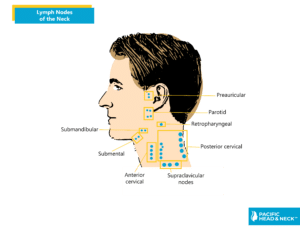Many cases of head and neck cancer metastasize, or spread, through the neck or cervical lymph nodes. While these metastasized cells are sometimes large enough to be detected through imaging exams, they are often microscopic and therefore undetectable through traditional modalities. There are several different types of neck dissection procedures. The best type for each patient will be determined after a thorough evaluation of your condition by an experienced doctor.
The lymph nodes are part of the lymphatic system. The lymphatic system helps fight infections and is made up of lymph vessels, lymph fluid, lymph nodes, bone marrow and the lymphatic organs (thymus, adenoid, tonsil and spleen).
Lymph vessels are thin tubes similar to blood vessels. They collect and move lymph fluid away from tissues into the lymph nodes. Lymph nodes are small bean-shaped organs of lymphatic tissue. The lymph fluid can carry cancer cells from where the cancer started into the lymph nodes. With head and neck cancers, the lymph fluid can sometimes carry cancer cells into the cervical lymph nodes.

Diagnosis
To diagnose lymph nodes, the following may be done:
- Examinations:
- A physical exam to check the lymph nodes near the surface of your skin for size, tenderness, and texture.
- Blood Tests:
- Certain blood tests may help confirm or exclude any suspected underlying conditions.
- Lymph Node Biopsy:
- To secure a diagnosis, a biopsy would have to be completed to remove a sample from a lymph node.








